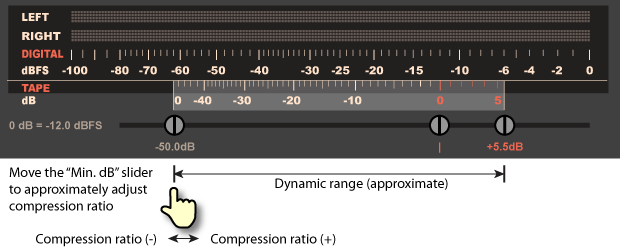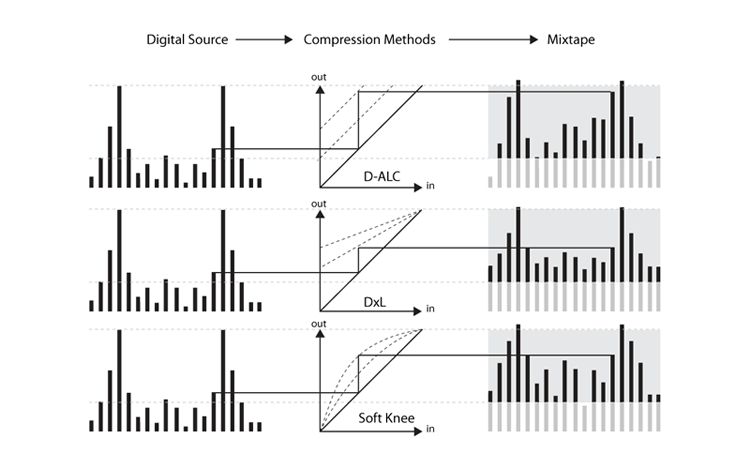Compression
Generally, analog tape is incapable of accommodating digital audio in terms of dynamic range. Fortunately, the extended dynamic range of digital audio often remains underutilized. For example, many contemporary pop music tracks exhibit modest dynamic ranges, particularly in the early decade of the 21st century, where the infamous loudness wars have spawned an abundance of over-compressed audio content with poor dynamic depth. They can be easily transferred to analog tape without any compression. However, this does not imply that the digital to analog transfer is always safe. When using faithful digital audio sources for making an analog mixtape, a dynamic range mismatch may occur anytime, making compression inevitable. In such cases, there are only two choices: controlled compression or uncontrolled compression. While some people do favour the sound of uncontrolled compression when magnetic tape is overly stressed, for others, who prefer to control the compression, this app provides 3 options., each with pros and cons, as detailed below:

⬤ D-ALC
This compressor is a digital version of the traditional Automatic Level Controller. When processing a highly dynamic audio content, this compressor constantly monitors the audio level and adjust the recording gain accordingly, so as to keep the peak level below the clipping threshold while also maintaining the lower level above the noise floor. Compared to the traditional analog ALC, the digital ALC here is able to foresee the input signal before it is processed, so that it can react on sharp overshoots in advance and thus reduces transient clipping distortion. This compressor doesn't operate at a constant compression ratio. However, the maximum amount of compression can be roughly adjusted by moving the "-SNR" slider (refer to the pic provided at the bottom) — the more it is moved toward the "MOL" slider, the higher the maximum amount will be, or vice versa. The downside of ALC type of compressor is that it may sound a little bit unnatural.
⬤ DxL
This compressor is particularly effective at boosting quieter passages up above the tape noise floor, making it suitable for recording highly dynamic audio contents with many quiet passages (e.g.: classical music) onto analog tape, or creating a mixtape for listening in noisy environments such as moving cars. However, it is less suitable for processing audio materials already having significant noises. The compressor in this app is essentially a digital equivalent of the analog logarithm (aka: linear decibel) compressor, commonly provided by dbx inc. (but not the complementary dbx-I/II NR). Its compression ratio can be roughly adjusted by moving the "-SNR" slider closer/farther to the "MOL" slider (refer to the pic provided at the bottom), resulting in higher/lower compression ratio. Due to its relatively longer attack time constant, this traditional compressor may allow sharp overshoots to pass through and reach the tape without warning, or exhibit a "pumping" effect when the compression ratio is set too high.
⬤ Soft Knee
This compressor reduces dynamic range by reducing the crest factor of the source audio. It applies a Bezier curve (ultra soft knee) to the original energy distribution. Such a curve can effectively boost the average energy without significantly amplifying the peaks and valleys, so that the result will sound intenser without introducing excessive artifacts. The Soft Knee compressor in this app incorporates a lookahead feature, which can analyze the input signal in advance and reacts with a negative attack time, effectively preventing transient clipping distortion caused by abrupt overshoot. Its compression ratio can be roughly adjusted by moving the "-SNR" slider closer/farther to the "MOL" slider (refer to the pic provided at the bottom), resulting in higher/lower compression ratio.

Note 2: When using a compressor, it is recommanded to just use the "Peak" normalizer, as using a compressor will have significant impact to the accuracy of other normalizers.
Note 3: Here the term "compression" reffers to dynamic range comression, which is a totally diferent concept from the same term used for reducing audio file size, such as MP3 compression.
Note 4: Sometimes, these compressors can be applied aggressively for special purposes. For example, making a mixtape that can be enjoyed in noisy environments, such as in car or in public transit.
